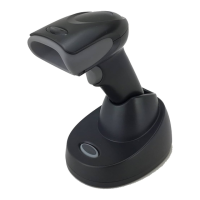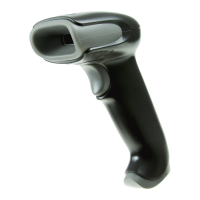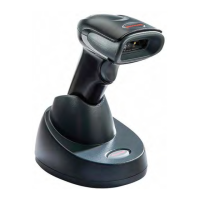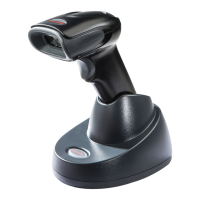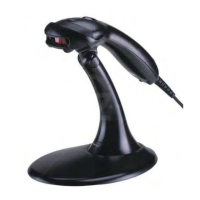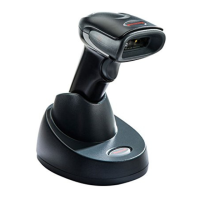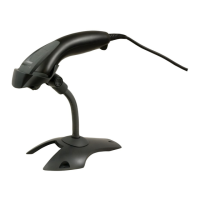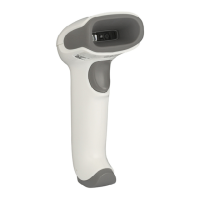
Do you have a question about the Honeywell Voyager XP 147 Series and is the answer not in the manual?
| Connectivity | USB, RS-232, Keyboard Wedge |
|---|---|
| Symbol Contrast | 20% |
| Operating Temperature | 0°C to 50°C (32°F to 122°F) |
| Storage Temperature | -40°F to 140°F (-40°C to 60°C) |
| Humidity | 5% to 95% (non-condensing) |
| Drop | 6 feet (1.8 meters) to concrete |
| Light Levels | 0 to 100, 000 lux |
| Ambient Light Immunity | 100, 000 Lux |
| Resolution | 0.1 mm (4 mil) |
Provides installation and programming instructions for Voyager XP scanners and related information.
Steps for unpacking the scanner and checking for damage during shipment.
Connects scanner or base to a computer's USB port for data transfer.
Connects scanner between keyboard and PC for data output similar to keyboard entries.
Connects scanner to PC or terminal serial port for data transmission.
Connects scanner to IBM POS terminal interface for data.
Explains how to use the scanner's aiming dot for effective barcode reading.
Allows creation of custom defaults by scanning menu commands and saving them.
Restores scanner to custom default settings or factory defaults if no custom defaults exist.
Provides instant scanner setup for commonly used interfaces via barcodes.
Allows laptop operation of scanner in parallel with the integral keyboard.
Connects to PC or terminal serial port, programs CR/LF suffix, baud rate, and data format.
Programs scanner for USB PC or Macintosh keyboard, adds CR/LF.
Sets the keyboard layout for USB Keyboard or Keyboard Wedge interfaces to various countries.
Sets the data transmission rate between scanner and terminal.
Configures word length, stop bits, and parity for serial data transmission.
Steps to establish a link between the scanner and the charge base.
Establishes a connection between the Access Point and the scanner.
Stores menu parameters and settings in the charge base or Access Point.
Information about the rechargeable battery, initial charge, and warnings.
Lists safety guidelines for handling and disposing of lithium batteries.
Reboots the scanner and causes it to relink with the base or Access Point.
Specifies how scanner battery is charged via host interface cable or external power.
Stores barcode data when scanner is out of range or for inventory.
Allows linking up to 3 scanners to one base or Access Point.
Organizes scanners into groups for unique settings or common programming.
Pairs scanner with Bluetooth devices for screen data input via keyboard emulation.
Validates incoming barcode data and provides acknowledgment to the scanner.
Programs the scanner and base to beep when powered up.
Enables or disables the beeper response to a good read indication.
Sets the minimum time before the scanner can read another barcode.
Scanner scans until barcode read or trigger released.
Uses ambient light to detect barcodes; LED dims until barcode is presented.
Improves reading of damaged or badly printed linear barcodes.
Uses trigger to allow decoded data transmission to host.
Sets scanner orientation for direction-sensitive codes like KIX.
Explains how to add data characters before or after scanned data to build a message string.
Step-by-step guide to adding prefixes or suffixes to symbologies.
Transmits function codes contained within scanned data to the terminal.
Slows data transmission to increase integrity when terminals drop characters.
Explains changing scanner output by inserting characters into barcode data.
Guides through creating and saving data formats for scanner output.
Lists commands to move cursor and select/replace/insert data in output strings.
Commands to send all or a number of characters, or up to a particular character.
Commands to move the cursor forward, backward, or to the beginning of the input message.
Commands to search forward or backward for characters or non-matching characters.
Lists available barcode symbologies and related settings.
Enables or disables all symbologies for optimal scanner performance.
Explains setting minimum/maximum lengths to force fixed-length barcode data.
Default settings and options for Codabar symbology.
Default settings and options for Code 39 symbology.
Default settings and options for Interleaved 2 of 5 symbology.
Default settings and options for NEC 2 of 5 symbology.
Default settings and options for Code 93 symbology.
Default settings and options for Straight 2 of 5 Industrial symbology.
Default settings and options for Straight 2 of 5 IATA symbology.
Default settings and options for Matrix 2 of 5 symbology.
Default settings and options for Code 11 symbology.
Default settings and options for Code 128 symbology.
Default settings and options for GS1-128 symbology.
Default settings and options for UPC-A symbology.
Adds 2 or 5 digits to the end of scanned UPC-A data.
Enables/disables UPC-A and EAN-13 with Extended Coupon Code.
Automatically formats GS1 data carrier output to emulate GS1-128 or GS1 DataBar.
Default settings and options for QR Code symbology.
Default settings and options for Data Matrix symbology.
Default settings and options for MaxiCode symbology.
Default settings and options for Aztec Code symbology.
Lists possible 2D postal codes and combinations.
Lists linear postal codes and their possible combinations.
Default settings and options for China Post (Hong Kong 2 of 5) symbology.
Default settings and options for Korea Post symbology.
Turns on transmission of Code I.D. before decoded symbology temporarily.
Outputs current software revision, serial number, and product information.
Introduces PC-based programming functions for scanner configuration and firmware upgrades.
Erases all settings and resets the scanner to original factory defaults.
Explains conventions used for menu and query command descriptions.
Defines the syntax for menu commands, including prefix and name usage.
Uses special characters to query device settings like default, current value, or range.
Lists available menu commands, their settings, serial commands, and page references.
Details mechanical, electrical, and environmental specifications for the 1470g scanner.
Details mechanical, electrical, radio, and environmental specs for the 1472g scanner.
Details dimensions, electrical, radio, and temperature specifications for the charge base.
Provides typical performance data for barcode reading distance based on symbology and size.
Information on pin assignments for scanner interface cables.
States that repairs/upgrades must be done by authorized service centers.
Instructions for cleaning the scanner housing and window with soft cloth and mild solutions.
Instructions for replacing the interface cable on corded scanners.
Step-by-step guide for replacing the interface cable in the base unit.
Instructions for removing the end cap and replacing the scanner battery.
Guide to isolate problems with corded scanners by checking power, aimer, and symbols.
General troubleshooting for cordless systems, including base and scanner issues.
Troubleshooting steps for base issues, checking LED indicators and power.
Troubleshooting scanner issues like symbol reading and barcode display problems.

